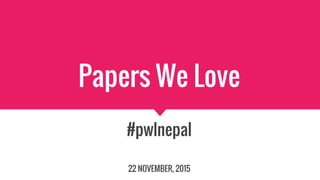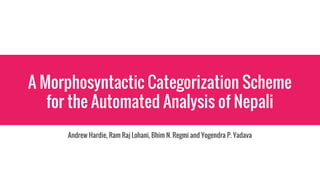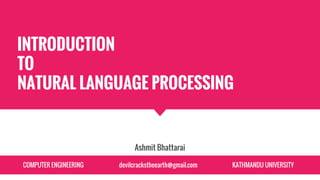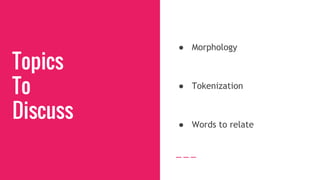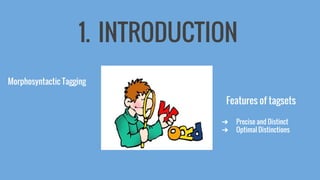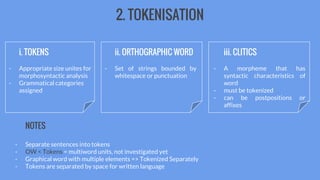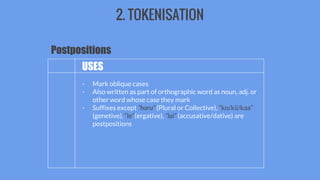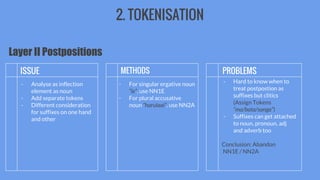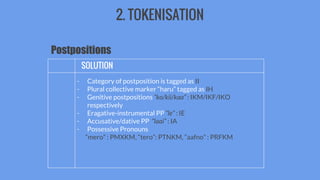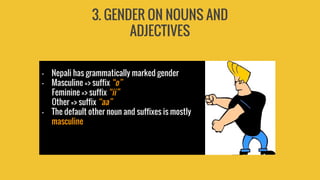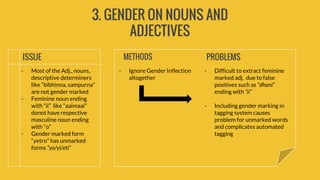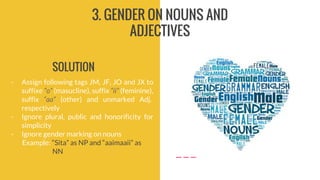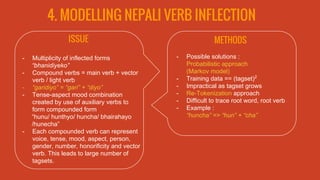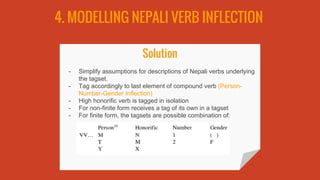A morphosyntactic-categorization-scheme-for-the-automated-analysis-of-nepali
- 1. Papers We Love #pwlnepal 22 NOVEMBER, 2015
- 2. A Morphosyntactic Categorization Scheme for the Automated Analysis of Nepali Andrew Hardie, Ram Raj Lohani, Bhim N. Regmi and Yogendra P. Yadava
- 3. INTRODUCTION TO NATURAL LANGUAGE PROCESSING Ashmit Bhattarai COMPUTER ENGINEERING devilcrackstheearth@gmail.com KATHMANDU UNIVERSITY
- 4. Topics To Discuss ŌŚÅ Morphology ŌŚÅ Tokenization ŌŚÅ Words to relate
- 5. 1. INTRODUCTION Morphosyntactic Tagging Features of tagsets Ō×ö Precise and Distinct Ō×ö Optimal Distinctions
- 6. 2. TOKENISATION i. TOKENS - Appropriate size unites for morphosyntactic analysis - Grammatical categories assigned ii. ORTHOGRAPHIC WORD - Set of strings bounded by whitespace or punctuation NOTES - Separate sentences into tokens - OW < Tokens = multiword units, not investigated yet - Graphical word with multiple elements => Tokenized Separately - Tokens are separated by space for written language iii. CLITICS - A morpheme that has syntactic characteristics of word - must be tokenized - can be postpositions or affixes
- 7. 2. TOKENISATION - Mark oblique cases - Also written as part of orthographic word as noun, adj. or other word whose case they mark - Suffixes except ŌĆ£haruŌĆØ (Plural or Collective), ŌĆ£ko/kii/kaaŌĆØ (genetive), ŌĆ£leŌĆØ(ergative), ŌĆ£laiŌĆØ (accusative/dative) are postpositions Postpositions USES
- 8. 2. TOKENISATION ISSUE - Analyse as inflection element as noun - Add separate tokens - Different consideration for suffixes on one hand and other METHODS PROBLEMS - For singular ergative noun ŌĆ£leŌĆØ, use NN1E - For plural accusative noun ŌĆØharulaaiŌĆØ, use NN2A Layer II Postpositions - Hard to know when to treat postpostion as suffixes but clitics (Assign Tokens ŌĆ£ma/bata/sangaŌĆØ) - Suffixes can get attached to noun, pronoun, adj and adverb too Conclusion: Abandon NN1E / NN2A
- 9. 2. TOKENISATION SOLUTION - Category of postposition is tagged as II - Plural collective marker ŌĆ£haruŌĆØ tagged as IH - Genitive postpositions ŌĆ£ko/kii/kaaŌĆØ : IKM/IKF/IKO respectively - Eragative-instrumental PP ŌĆ£leŌĆØ : IE - Accusative/dative PP ŌĆØlaaiŌĆØ : IA - Possessive Pronouns ŌĆ£meroŌĆØ : PMXKM, ŌĆ£teroŌĆØ: PTNKM, ŌĆ£aafnoŌĆØ : PRFKM Postpositions
- 10. 3. GENDER ON NOUNS AND ADJECTIVES - Nepali has grammatically marked gender - Masculine => suffix ŌĆ£oŌĆØ Feminine => suffix ŌĆ£iiŌĆØ Other => suffix ŌĆ£aaŌĆØ - The default other noun and suffixes is mostly masculine
- 11. 3. GENDER ON NOUNS AND ADJECTIVES ISSUE - Most of the Adj., nouns, descriptive determiners like ŌĆ£bibhinna, sampurnaŌĆØ are not gender marked - Feminine noun ending with ŌĆ£iiŌĆØ like ŌĆ£aaimaaiŌĆØ donot have respective masculine noun ending with ŌĆ£oŌĆØ - Gender marked form ŌĆ£yetroŌĆØ has unmarked forms ŌĆ£yo/yi/etiŌĆØ METHODS PROBLEMS - Ignore Gender Inflection altogether - Difficult to extract feminine marked adj. due to false positives such as ŌĆ£dhaniŌĆØ ending with ŌĆ£iiŌĆØ - Including gender marking in tagging system causes problem for unmarked words and complicates automated tagging
- 12. 3. GENDER ON NOUNS AND ADJECTIVES - Assign following tags JM, JF, JO and JX to suffixe ŌĆ£oŌĆØ (masucline), suffix ŌĆ£iiŌĆØ (feminine), suffix ŌĆ£aaŌĆØ (other) and unmarked Adj. respectively - Ignore plural, public and honorificity for simplicity - Ignore gender marking on nouns Example: ŌĆ£SitaŌĆØ as NP and ŌĆ£aaimaaiiŌĆØ as NN SOLUTION
- 13. 4. MODELLING NEPALI VERB INFLECTION ISSUE - Multiplicity of inflected forms ŌĆ£bhanidiyekoŌĆØ - Compound verbs = main verb + vector verb / light verb - ŌĆ£garidiyoŌĆØ = ŌĆ£gariŌĆØ + ŌĆ£diyoŌĆØ - Tense-aspect mood combination created by use of auxiliary verbs to form compounded form ŌĆ£hunu/ hunthyo/ huncha/ bhairahayo /hunechaŌĆØ - Each compounded verb can represent voice, tense, mood, aspect, person, gender, number, honorificity and vector verb. This leads to large number of tagsets. METHODS - Possible solutions : Probabilistic approach (Markov model) - Training data == (tagset)2 - Impractical as tagset grows - Re-Tokenization approach - Difficult to trace root word, root verb - Example : ŌĆ£hunchaŌĆØ => ŌĆ£hunŌĆØ + ŌĆ£chaŌĆØ
- 14. Solution - Simplify assumptions for descriptions of Nepali verbs underlying the tagset. - Tag accordingly to last element of compound verb (Person- Number-Gender Inflection) - High honorific verb is tagged in isolation - For non-finite form receives a tag of its own in a tagset - For finite form, the tagsets are possible combination of: 4. MODELLING NEPALI VERB INFLECTION
